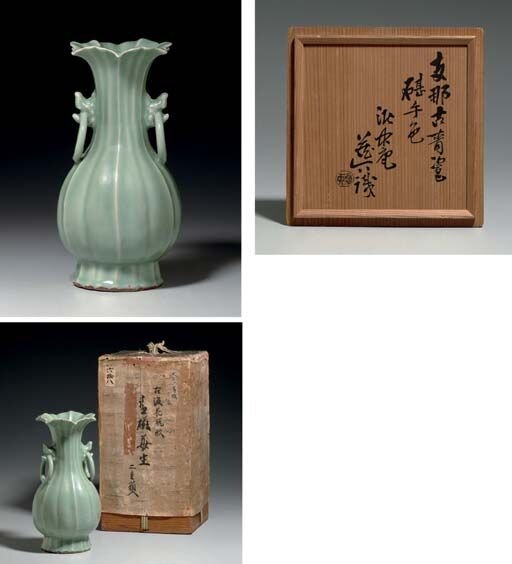The body molded with six lobes rising from a conforming pedestal foot to the everted barbed rim, the neck flanked by a pair of lion-mask handles suspending fixed rings, covered overall with a glaze of soft sea-green tone that thins on the ribs, the interior of the foot similarly glazed, Japanese wood box.
Provenance: Japanese private collection.
Note: A very similar vase in the Chang Foundation is illustrated by J. Spencer, Selected Chinese Ceramics from Han to Qing Dynasties, Taipei, 1990, pp. 162-3, no. 62, where it is described as being of mallow section. Two other similar vases, dated Yuan dynasty, are illustrated in the exhibition catalogue, Xin'an Haidi Wenwu (Cultural Relics from the Sinan Seabed), National Museum of Korea, 1977, nos. 44 and 45.
Other Longquan celadon vases with fluted bodies of different shape were made during this period. Two related vases with fluted body, but of quadrangular pear shape and without handles, are illustrated in Newly Discovered Southern Song Ceramics: A Thirteenth-Century "Time Capsule", Tokyo, 1999, pp. 26-7, nos. 16 and 17. Another related vase with fluted pear-shaped body, also of quadrangular section and without handles, is illustrated in Celadons from Longquan Kilns, Beijing, 1998, p. 151, no. 118-1, and a non-fluted pear-shaped vase with similar handles, but decorated in relief with peony scroll, is illustrated ibid., p. 183, pl. 156.
The Japanese inscription on the interior cover of the box is an authentication by the potter Zoroku (1822-1877), known for his celadon glazes, who identifies the present lot as seiji kinuta.
Christie's. Fine Chinese Ceramics & Works of Art, New York, 22 March 2007

/https%3A%2F%2Fprofilepics.canalblog.com%2Fprofilepics%2F1%2F0%2F100183.jpg)
/https%3A%2F%2Fstorage.canalblog.com%2F03%2F02%2F119589%2F96711876_o.jpg)
/https%3A%2F%2Fstorage.canalblog.com%2F11%2F31%2F119589%2F94773502_o.jpg)
/https%3A%2F%2Fstorage.canalblog.com%2F20%2F83%2F119589%2F94772815_o.jpg)
/https%3A%2F%2Fstorage.canalblog.com%2F26%2F72%2F119589%2F75604929_o.jpg)
/https%3A%2F%2Fstorage.canalblog.com%2F59%2F60%2F119589%2F26458628_o.jpg)



/http%3A%2F%2Fstorage.canalblog.com%2F41%2F21%2F119589%2F127641215_o.jpg)
/http%3A%2F%2Fstorage.canalblog.com%2F91%2F30%2F119589%2F126160632_o.jpg)
/http%3A%2F%2Fstorage.canalblog.com%2F15%2F06%2F119589%2F126160241_o.jpg)
/http%3A%2F%2Fstorage.canalblog.com%2F01%2F87%2F119589%2F126159930_o.jpg)